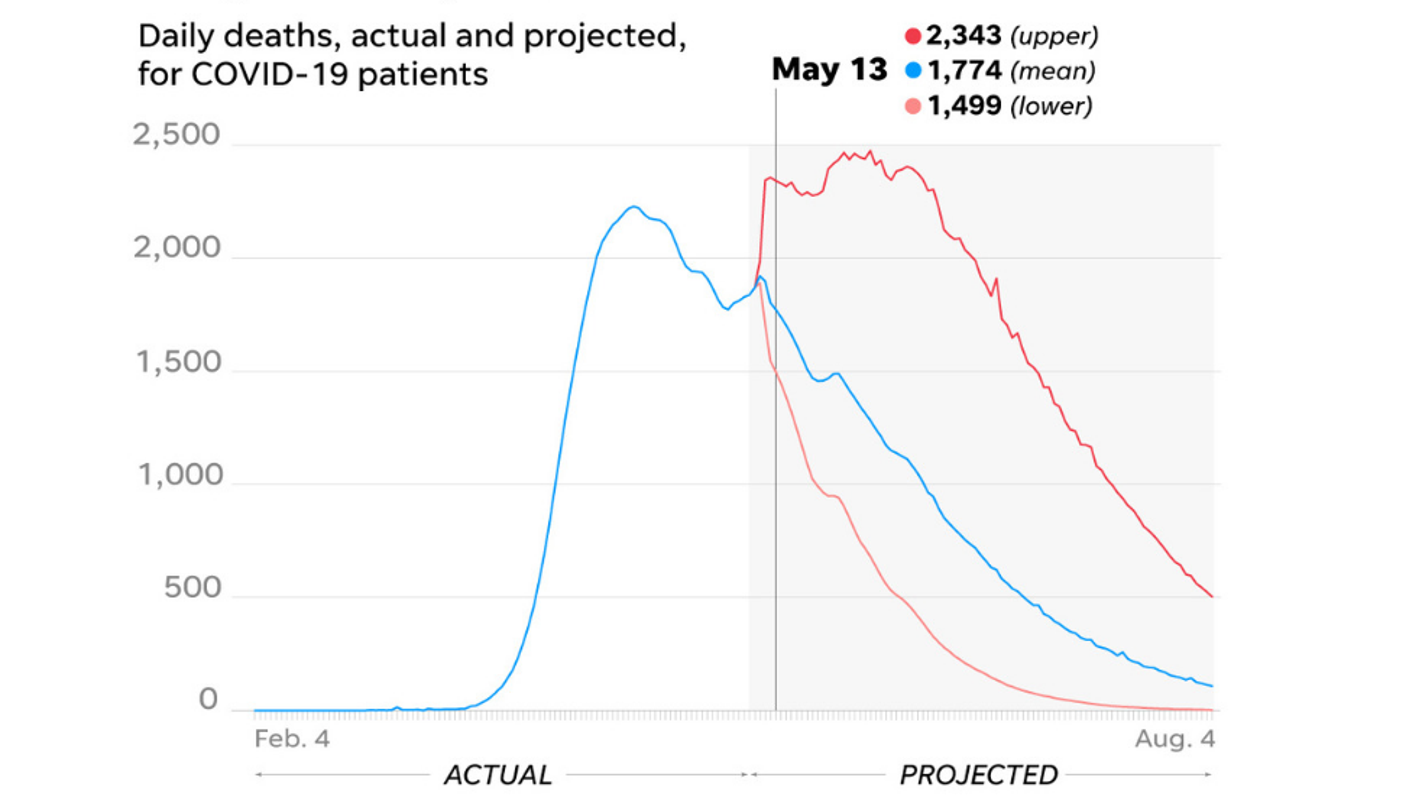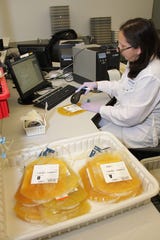
John Bacon, USA TODAY Published 6:59 a.m. ET May 13, 2020 | Updated 1:50 p.m. ET May 13, 2020
CLOSE![]()
The secret to fighting COVID-19 could be in recovered patients. Here’s how antibodies could lead to a treatment for those fighting coronavirus. USA TODAY
CONNECTEMAILMORE
The national curve finally appears to be flattening – for now.
The Johns Hopkins dashboard, which has become the statistical bible for data on the coronavirus outbreak, shows the rise of confirmed cases and daily deaths in the U.S. may be slowing, even as the national death total approaches 100,000. Worldometer statistics, run by the data company Dadax, hint at steady declines.
And the Institute for Health Metrics and Evaluation at the University of Washington,a leading model, released projections this week that show a steady decline for daily deaths – falling to 100 or less by early August.
The positive trends, however, come against another grim estimate released this week: The institute estimates a total death toll of 147,000 by August, or more than 60,000 additional U.S. deaths.
As sometimes seemingly conflicting numbers roll out each week, it can be confusing for ordinary Americans to digest just where the U.S. stands in its battle against the deadly virus, experts acknowledge. But the encouraging data and trends shouldn’t be wholly dismissed, they say.
Top takeaways from Senate hearing: Fauci says vaccine ‘likely,’ but not in time for school
Dr. Marjorie Jenkins, dean of the University of South Carolina School of Medicine Greenville, warns that projections have fluctuated greatly in the months since the outbreak began sweeping the nation. But she says the data provides promising reflections of nationwide mitigation efforts.
“Data is vital to informed decision-making,” she said, adding that federal, state and local leaders trying to navigate the outbreak “continue to face unprecedented challenges.”
Ogbonnaya Omenka, public health expert and assistant professor at Butler University, says the data points to a decline in new cases and mortality rates. However, the IHME estimates are hinged on “existing determinants” that can change at any time, he said.
With antibody testing still in the nascent stages, and the unavailability of therapies or vaccines, the population remains vulnerable, Omenka said. The nation must get to the “endemic phase” of the infection – a containable level at which it could remain long term, such as chicken pox – before we can confidently start talking about the end of the pandemic, he said.

Blood plasma is processed at the New York Blood Center in New York City. An experimental treatment is being tried to use blood plasma from people who have recovered from COVID-19 to treat patients who are severely ill with the disease. (Photo: New York Blood Center)
“Based on current circumstances, we are not close to that yet,” Omenka said.
Because the rise and fall of the curve is not uniform nationally, it’s not easy to determine how to reopen safely, Omenka added.
“With the resumption of public activities in different states, we are yet to learn whether a resurgence in cases and mortality would result,” he said. “Individual jurisdictions still paint the clearest picture of where we are.”
Dennis Carroll, who led the U.S. Agency for International Development’s infectious disease unit for more than a decade, says the data on deaths and even confirmed cases “is really a look in the rear view mirror.”
“Deaths are about who was infected three weeks ago,” Carroll says. “With the rapid suspension of these (mitigation) measures, we’re in a brave new world.”
COVID miracle: California man with 1% chance of survival released from hospital after two-month COVID-19 battle
Dr. Anthony Fauci, director of the National Institute of Allergy and Infectious Diseases, says don’t expect COVID-19 to disappear from the nation or the national psyche until a vaccine is developed and widely distributed.
“That is just not going to happen because it’s such a highly transmissible virus,” Fauci told a Senate hearing Tuesday. “Even if we get better control over the summer months, it is likely that there will be virus somewhere on this planet that will eventually get back to us.”
Enter the race for a vaccine. Fauci said he was hopeful a safe, effective vaccine could be developed by winter. World Health Organization Director-General Tedros Adhanom Ghebreyesus said this week that a global effort could compress the timeline that had been projected at 12 to 18 months but provided no new timeline. Researchers at Oxford University are the most optimistic: They hope to have 1 million vaccine doses by September.
Even the best estimates won’t blanket the nation or the world in vaccine by autumn, when Fauci and others warn of a possible second round of infections.
Fauci warned again Tuesday that reopening the country amid the coronavirus may lead to “some suffering and death.” Carroll agrees.
“What we are seeing in current data is a reflection of what we were doing was working,” he said. “The pivot to reopening without adequate testing and contact tracing does not bode well for the coming months.”
Stimulus plan: Democrats’ $3 trillion coronavirus stimulus proposal includes more $1,200 checks
Testimony at Senate hearing: Romney says US coronavirus testing is ‘nothing to celebrate’
CLOSE![]()
Dr. Anthony Fauci told senators “it is without a doubt that there will be infections” in the fall and warned of more deaths without adequate response. USA TODAY
State by state reopenings:How America is reopening amid coronavirus pandemic.
CONNECTEMAILMORE
Read or Share this story: https://www.usatoday.com/story/news/health/2020/05/13/coronavirus-positive-trends-shouldnt-dismissed-experts-say/3115194001/
Share your feedback to help improve our site experience!

